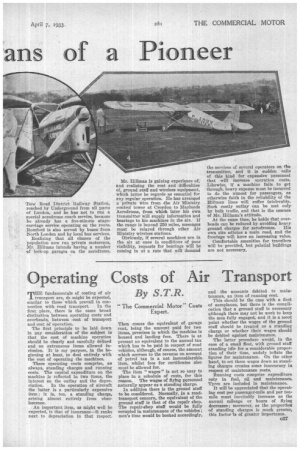peratin (Ii
Page 59

If you've noticed an error in this article please click here to report it so we can fix it.
Costs of Air Transport
/a) ,p
y S.71 lir "The Commercial Motor" Costs Expert.
MLLE fundamentals of costing of air transpout are, its might be expected, similar to those which prevail in connection with road transport. In the first place, there is the same broad distinction between operating costs and overheads, between .cost of • transport and cost of operation.
The first principle to be laid down in any consideration of the subject is that the cost of machine operation should be clearly and carefully defined and no extraneous items allowed inclusion. It is my purpose, in the beginning at least, to deal entirely with the cost of operating the machines.
These operating costs comprise, as always, standing charges and running costs. The capital expenditure on the machine is reflected in two items, the interest on the outlay and the depre
ciation. In the operation of aircraft the latter is a particularly expensive item ; it is, too, a standing charge, arising almost entirely from obsolescence.
An important item, as might well be expected, is that of insurance—it ranks next to depreciation in that respect. Then comes the equivalent of garage rent, being the amount paid for two items, premises in which the machine is housed and landing fees. There is at present no equivalent to the annual tax which has to be paid in respect of road vehicles, although, of course, the amount which accrues to the revenue on account of petrol tax is a not inconsiderable item, whilst fees for certificates also must be allowed for.
The item "wages" is not so easy to place in a schedule of costs, for this reason. The wages of flying personnel naturally appear as a standing charge. In addition there is the ground staff to be considered. Normally, in a roadtransport concern, the equivalent of the ground staff is that of the repair shop. The repair-shop staff would be fully occupied in maintenance of the vehicles; men's time would be booked accordingly,
and the amounts debited to maintenance, an item of running cost. This should be the case with a fleet of aeroplanes, but there is the complication that a ground staff is necessary although there may not be work to keep the men fully engaged, and it is a moot point whether the wages of the ground staff should be treated as a standing charge or whether their wages should be debited against maintenance.
The latter procedure would, in the case of a small fleet, with ground staff standing idle for a'considerable proportion of their time, unduly inflate the figures for maintenance. On the other hand, to set these wages down as standing charges creates some inaccuracy in respect of maintenance costs.
Running costs comprise expenditure only in fuel, oil and maintenance. Tyres are included in maintenance.
It will be appreciated that the operating cost per passenger-mile and per tonmile must inevitably increase as the annual mileage or hours of flying decreases; moreover, as the proportion of standing charges is much greater, this factor is of greater importance.












































































































